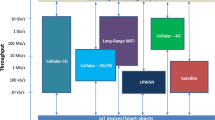Abstract
LTE Machine Type Communication Category M1 [LTE CAT M (or M1)] is a 3GPP Low Power Wide Area Network most suitable for IoT devices that need low data rates, deep coverage, low-cost, and, most importantly, power-efficient devices. As the number of IoT system devices (called things) is growing massively, there is a shift needed from the traditional LTE network to these low power networks. Power consumption should be minimum for all stages of device functionality to keep the devices working for longest possible time. We performed a power consumption analysis of CAT-M technology under various control path scenarios using a standard CAT-M modem. Due to the absence of a live CAT-M network in India, we use a network simulator to emulate live network scenario by varying network parameters. We measured the power consumed by the CAT-M modem using a standard tool and present simulation results of a variety of network configurable parameters allowed by 3GPP. These parameters are configurable both in scope of user equipment and network deployment. This paper covers some important power measurements related to Power Saving Mode (PSM), extended Discontinuous Reception Mode (eDRX), Uplink Transmission Power, Channel Repetition, Bandwidth and Sub-carrier Spacing. Data path (user payload) considerations are not scope of this document. By the end of the paper, we identified the impact of each parameter on the performance of the CAT-M modem.









Similar content being viewed by others
References
www.statista.com article. Accessed 3 Mar 2020
Li Y, Cheng X, Cao Y, Wang D, Yang L (2018) Smart choice for the smart grid: narrowband internet of things (NB-IOT). IEEE Int Things J 5(3):1505–1515
Chen J, Hu K, Wang Q, Sun Y, Shi Z, He S (2017) Narrowband internet of things: implementations and applications. IEEE Int Things J 4(6):2309–2314
https://www.statista.com/statistics/471264/iot-number-of-connected-devices-worldwide/. Accessed 01 May 2020
Keysight technologies paper (2020) Power-consumption measurements for LTE user equipment. https://www.keysight.com/us/en/assets/7018-04424/application-notes/5991-4594.pdf. Accessed 15 Jun 2020
GSMA white paper (2016) 3GPP low power wide area technologies. https://www.gsma.com/IOT/wp-content/uploads/2016/10/3GPP-Low-Power-Wide-Area-Technologies-GSMA-White-Paper.pdf. Accessed 24 Apr 2020
Ratasuk R, Mangalvedhe N, Bhatoolaul D, Ghosh A (2017) LTE-M evolution towards 5G massive MTC. 2017 IEEE globecom workshops (GC Wkshps), Singapore 1–6
Benhiba BE, Madi AA, Addaim A (2018) Comparative study of the various new cellular IoT technologies. 2018 international conference on electronics, control, optimization and computer science (ICECOCS), Kenitra 1–4
Wang H, Fapojuwo AO (2017) A survey of enabling technologies of low power and long range machine-to-machine communications. IEEE Commun Surv Tutor 19(4):2621–2639
Lauridsen M, Kovacs IZ, Mogensen P, Sorensen M, Holst S (2016) Coverage and capacity analysis of LTE-M and NB-IoT in a Rural Area. 2016 IEEE 84th vehicular technology conference (VTC-Fall), Montreal, QC, pp 1–5
Chen M, Miao Y, Jian X, Wang X, Humar I (2019) Cognitive-LPWAN: towards intelligent wireless services in hybrid low power wide area networks. IEEE Trans Green Commun Netw 3(2):409–417
Dawaliby S, Bradai A, Pousset Y (2016) In depth performance evaluation of LTE-M for M2M communications. 2016 IEEE 12th international conference on wireless and mobile computing, networking and communications (WiMob), New York, NY pp 1–8
Apilo O, Mäkelä J, Kuosmonen A (2019) Evaluation of cellular IoT for sport wearables, 2019 IEEE 30th international symposium on personal, indoor and mobile radio communications (PIMRC Workshops), Istanbul, Turkey, pp 1–7
Andres-Maldonado P, Ameigeiras P, Prados-Garzon J, Navarro-Ortiz J, Lopez-Soler JM (2019) An analytical performance evaluation framework for NB-IOT. IEEE Int Things J 6(4):7232–7240
Masek P, Stusek M, Zeman K, Drapela R, Ometov A, Hosek J (2019) Implementation of 3GPP LTE Cat-M1 technology in NS-3: system simulation and performance, 2019 11th international congress on ultra modern telecommunications and control systems and workshops (ICUMT), Dublin, Ireland, pp 1–7
Akpakwu GA, Silva BJ, Hancke GP, Abu-Mahfouz AM (2018) A survey on 5G networks for the internet of things: communication technologies and challenges. IEEE Access 6:3619–3647
LTE; Evolved Universal Terrestrial Radio Access (E-UTRA); Physical layer procedures (3GPP TS 36.213 version 13.8.0 Release 13)
Lauridsen M, Krigslund R, Rohr M, Madueno G (2018) An empirical NB-IoT power consumption model for battery lifetime estimation. 2018 IEEE 87th vehicular technology conference (VTC Spring), Porto, pp 1–5
Yang W et al (2017) Narrowband wireless access for low-power massive internet of things: a bandwidth perspective. IEEE Wireless Commun 24(3):138–145
GSMA LTE deployment Guide to basic feature set requirements (2018) https://www.gsma.com/iot/wp-content/uploads/2018/04/LTE-M_Deployment_Guide_v2_5Apr2018.pdf. Accessed 15 Jun 2020
Ikpehai A et al (2019) Low-power wide area network technologies for internet-of-things: a comparative review. IEEE Int Things J 6(2):2225–2240
Nsiah KA, Amjad Z, Sikora A, Hilt B (2019) Performance evaluation of latency for NB-LTE networks in industrial automation, 2019 IEEE 30th annual international symposium on personal, indoor and mobile radio communications (PIMRC), Istanbul, Turkey, pp 1–7
White Paper, Coverage Analysis of LTE-M category-M1 (2017) https://altair-semi.com/wp-content/uploads/2017/02/Coverage-Analysis-of-LTE-CAT-M1-White-Paper.pdf. Accessed 01 Jun 2020
Kabalcı Y, Ali M (2019) Emerging LPWAN technologies for smart environments: an outlook, 2019 1st global power, energy and communication conference (GPECOM), Nevsehir, Turkey, pp 24–29
Sikora A (2019) Performance measurements of narrowband-iot network in emulated and field testbeds. 2019 10th IEEE international conference on intelligent data acquisition and advanced computing systems: technology and applications (IDAACS), Metz, France 780–785. DOI: https://doi.org/10.1109/IDAACS.2019.8924357
Dian FJ, Vahidnia R (2020) LTE IoT technology enhancements and case studies. IEEE Cons Elect Mag 9(6):49–56. https://doi.org/10.1109/MCE.2020.2986834
Jörke P, Falkenberg R, Wietfeld C (2018) Power consumption analysis of NB-IoT and eMTC in challenging smart city environments, 2018 IEEE globecom workshops (GC Wkshps), Abu Dhabi, United Arab Emirates, pp 1–6
Author information
Authors and Affiliations
Corresponding author
Rights and permissions
About this article
Cite this article
Bhilwaria, H., Ranga, V. & Gargi, A. Critical power analysis for control path of a CAT-M based edge device. Int. j. inf. tecnol. 13, 845–855 (2021). https://doi.org/10.1007/s41870-021-00640-y
Received:
Accepted:
Published:
Issue Date:
DOI: https://doi.org/10.1007/s41870-021-00640-y




